Wild Connections – NCWF’s 2025 Year in Review
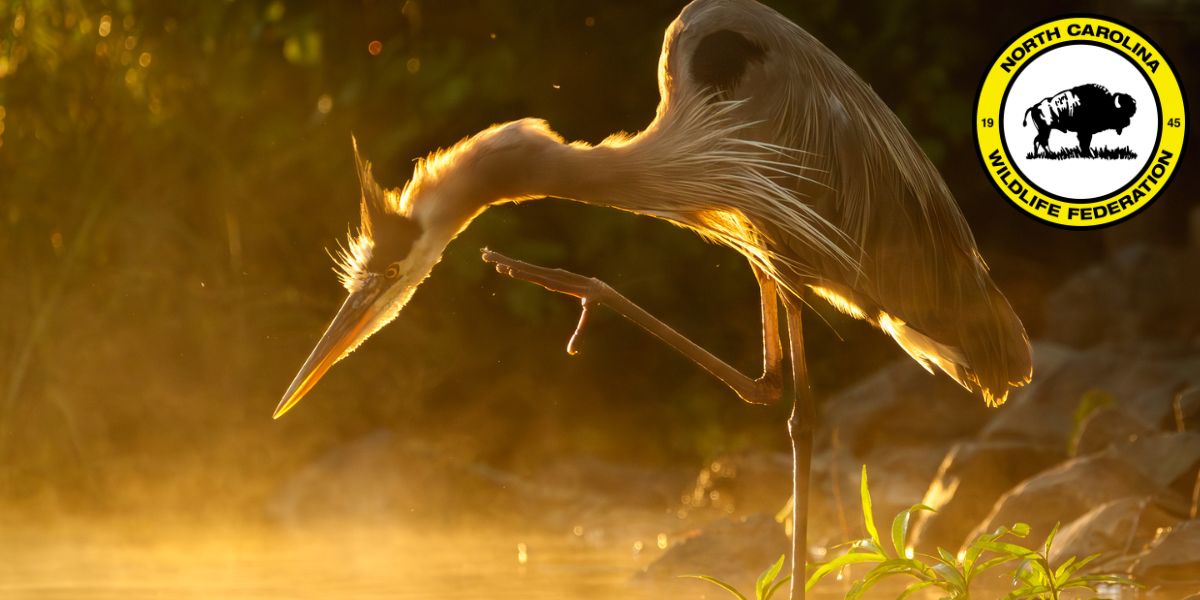
When you step outside – and if you look closely – you’ll notice something that exists everywhere: connections.
Walk into the woods and, beneath your feet, a vast network of mycorrhizal fungi threads through the soil, shuttling nutrients and, in some cases, even communication between living organisms. Stand in an overgrown field and you’ll see a dense patchwork of blackberry canes, broomgrass, saplings, and wildflowers woven tightly together. Rise above the land and the pattern expands: creeks, rivers, ponds, and lakes twist and braid across the landscape, irrigating life itself.
Some connections are obvious. Others remain invisible to us – the transfer of energy as a wasp sucks the juice from a muscadine, a crappie eats the wasp, an osprey eats the crappie, and so on, in a continuous circulation that defines ecosystem function. Connection is the quiet engine of life.
Yet many of these connections are fraying. Dams block ancient migration routes for spawning fish. Roads carve once-unbroken landscapes into isolated fragments. Native species are displaced by introduced invasive species, disrupting the connection of ecosystems and the relationship between predator and prey. These choices of severance were largely made for convenience, progress, and industry. But beneath them echoes an old and demoralizing sentiment, captured by former US vice president and political theorist John C. Calhoun: “Let us then bind the Republic together with a perfect system of roads and canals. Let us conquer space.”
Our connections to one another have suffered a similar fate. We seem more fragmented than ever – struggling to agree on trivial matters, let alone on how to care for wildlife and the natural world.
To conquer, in many ways, is to sever. Aldo Leopold recognized this when – talking about interconnected species and ecosystems – he lamented that “man always kills the thing he loves,” yet he also offered a path forward: a land ethic that could change the role of humans from conqueror of the land-community to plain member and citizen of it. It implies respect for his fellow members, and also respect for the community as such… we can be ethical only in relation to something we can see, feel, understand, love, or otherwise have faith in.
This year, the value and faith in these connections have shown through the work that NCWF, partners, and our broader conservation community have achieved. We have been connected to one another through restoring urban wildlife habitat, advocating for the reform of our coastal marine fisheries, standing up for endangered species and their protections, and addressing the aftermath of a hurricane that ravaged our state and its resources. The list goes on. And through all of this, one crucial thing has grounded and guided our work – wildlife: the neighbors and fellow members of our communities, landscapes, and ecosystems.
Wildlife reminds us of these connections – to the land and to each other. These connections – this faith – are ultimately what hold us together. And they are what can save us, and the wildlife that lives here with us.
This year reminded us that every thread in the natural world is connected – and that our own hands help determine whether those threads hold or fray. The work is far from over, and the urgency is unmistakable. But we hear the call clearly – woven into the current of our rivers, carried in the beating wings of a monarch, echoed in the rustle of longleaf pine needles, and voiced by all who stand determined to keep North Carolina’s wild heritage and legacy intact.
2025 Impact at a Glance
Habitat Restoration
- 69,351 native plants added
- 71,819 lbs. of litter removed
- 18 acres cleared of invasive plants
- 809 new Pollinator Pitstops (92.7% increase)
→ Rebuilding resilient ecosystems
Red Wolf Recovery
- 20 wild-born pups; 10–12 confirmed surviving
- First-ever cross-fostering of SAFE pups into the wild
- New abdominal trackers to monitor early survival
→ Critical progress for the world’s most endangered canid
Protecting Our Sounds
- Advocated for ending destructive inshore shrimp trawling
- Strengthened the Save Our Sounds campaign
→ Safeguarding juvenile fish and coastal habitats
Science & Innovation
- Wildlife surveys in the Craggy Mountains (bats & birds)
- Launched Butterfly Highway seed study
→ Data guiding long-term conservation
Pollinator & Bird Support
- Built 3 Chimney Swift Towers
- Supported frosted elfin research & monarch protections
→ Expanding pollinator and bird habitat statewide
People & Community
- 12,537 volunteers engaged
- 419 community programs delivered
- 3,302 youth connected to wildlife
- 126 Wildlife Habitat Stewards trained
→ Growing conservation leadership
Network Expansion
- 4 new Community Wildlife Chapters launched
→ Local conservation action across North Carolina
Wildlife
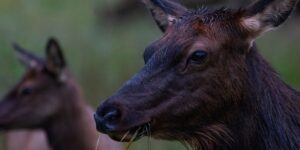
Photo: Elk (Cervus elaphus manitobensis) by John Andrew Lovins, NCWF Photo Contest Submission
“The world, we are told, was made especially for man – a presumption not supported by all the facts.” – John Muir
Conservation requires careful thought, long-term commitment, and a comprehensive understanding of both the living and nonliving components of ecosystems. To protect, conserve, and restore wildlife in North Carolina and beyond, we must approach it as one would a community relationship – constantly learning, caring for their wellbeing, shielding them from harm, and defending them in times of need.
Yet even as we work to restore habitats on the ground, the policies that safeguard those same ecosystems face new and unnecessary threats. Earlier this year, federal wildlife agencies proposed rolling back the long-standing definition of “harm” under the Endangered Species Act (ESA) – a change that would sharply weaken protections for imperiled species by discounting the very habitat loss that drives most extinctions. For more than five decades, the ESA has recognized that destroying or degrading essential habitat can kill or injure wildlife, a principle upheld by the Supreme Court and reaffirmed across administrations. This year, NCWF joined partners in opposing this abrupt reversal, emphasizing that meaningful conservation depends on protecting the places species need to survive.
Protecting and conserving wildlife requires more than on-the-ground action; it demands unwavering vigilance in the policy arena. As we restore habitat with our hands, we must also defend it with our voices, ensuring the laws that have protected species for generations remain intact. NCWF will continue to stand guard – because safeguarding wildlife means safeguarding the future we all share.
Supporting the State Wildlife Action Plan
This year, North Carolina Wildlife Federation submitted a letter supporting the North Carolina Wildlife Resources Commission’s (NCWRC) revised draft of the State Wildlife Action Plan (SWAP), which was prepared for the federal 10-year review. The updated plan reflects extensive outreach and collaboration, bringing together input from partners, stakeholders, and the public.
The revised SWAP provides a clear, science-based framework for addressing the needs of North Carolina’s wildlife, including Species of Greatest Conservation Need (SGCN). It emphasizes coordinated habitat conservation, improved management strategies, and effective education and outreach.
The plan advances a comprehensive, statewide approach to conserving biodiversity and strengthening partnerships across agencies, universities, nonprofits, and communities. Ultimately, the plan serves as a roadmap for proactive restoration and long-term protection of the state’s natural resources.
Marine Fisheries
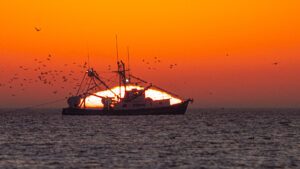
Photo by Mark Kwiatkowski
In North Carolina, large-scale inshore shrimp bottom trawling has long been one of the most destructive fishing practices with historic impacts on the Atlantic and Gulf coasts. Dragging heavy nets, doors, and chains across seagrass meadows, oyster beds, and other habitats devastates our fish nursery areas. For every pound of shrimp harvested, more than four pounds of bycatch – juvenile finfish and other species – are killed and wasted, directly contributing to collapsing fisheries.
This year, a major step forward came with House Bill 442, which the Senate amended to remove trawling from inshore waters and waters within one-half mile of the coast. This aligned North Carolina with Virginia and South Carolina and ended the state’s isolation as the only coastal state allowing large-scale bottom trawling in juvenile fish nursery areas.
Opposition to the legislation was immediate, led by commercial interests attempting to sow confusion and delay reform. While the House adjourned without taking up HB442, the need to protect juvenile fish and rebuild fisheries still remains urgent. Removing destructive bottom trawling from inshore nursery areas was essential to restoring ecosystems and supporting long-term economic health.
NCWF continues its Save Our Sounds campaign, addressing unsustainable marine resource management, and remains a key stakeholder in this work, advocating for science-based management of the state’s public trust resources.
Red Wolf Recovery Update

Six week old Red Wolf pups prior to their release into the wild with their parents, 2409F and 2371M. – USFWS
Red Wolves once roamed the eastern seaboard, from Pennsylvania to Florida and as far west as Texas. Today, they are the world’s most endangered canid, with the only remaining wild population in eastern North Carolina.
NCWF continues to partner with the U.S. Fish and Wildlife Service (USFWS) and other conservation organizations to support the Red Wolf Recovery Program. This spring, at least 20 pups were born across multiple wild Red Wolf family groups. Monitoring suggests that 10–12 of these pups remain on the landscape, a hopeful sign for the species’ future. Red Wolf pups are not collared until approximately their first winter, so they can be slightly more difficult to track during their first year.
Milltail Pack (2503F and 2191M)
This season brought remarkable changes for the Milltail family. Early in the bonding season, 2305F usurped her mother, 2225F, as the breeding female with 2191M, who was introduced to the wild from Wolf Haven International in 2024. This new pair produced eight pups in April, with at least five confirmed surviving. Notably, 2225F has been observed supporting the new pups, demonstrating the complex social structure of Red Wolf families in the wild.
Hopeful Legacy of 2443M
2443M, released in 2025 to pair with 2359F, successfully produced three pups in April. Tragically, 2443M was lost to a vehicle collision on Pocosin Lakes National Wildlife Refuge, but his genetic legacy continues through his offspring.
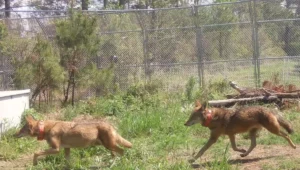
Red Wolves 2409F and 2371M in an acclimation pen on Alligator River National Wildlife Refuge prior to their release in late May. – USFWS
Rehabilitation and Successful Breeding of 2409F and 2371M
Following rehabilitation for a leg injury, 2409F was paired with 2371M in an acclimation pen. They produced a litter of three pups, two of which have survived and were released into the wild in May. The family group is thriving, contributing to the growing wild population.
First Cross-Fostering Effort in Red Wolf History
In a milestone for the Recovery Program, the wild pair 2412F and 2500M produced six pups, three of which were cross-fostered with SAFE Program pups to improve genetic diversity. All three cross-fostered pups are confirmed thriving as of early August.
Tracking Pups with Abdominal Transmitters
For the first time, USFWS inserted abdominal transmitters in five-week-old pups to track their movements before they are old enough for collars. This innovative tool, developed with Chowan Animal Hospital, helps biologists monitor pup survival during critical early weeks.
Red Wolf Center Breeding Pair
At the Red Wolf Center in Columbia, 2292F and 2445M remain together as part of the SAFE Breeding and Transfer Plan. While they did not produce pups this season, they will remain at the Center for the next breeding season with hopes of contributing to the species’ recovery.
Population Update
The SAFE Program now holds 280 Red Wolves, with 18 known collared wolves in the wild and an estimated total of 28–31 wild Red Wolves. Each successful pairing, pup birth, and fostering event represents a step forward in recovery, thanks to dedicated funders and the committed efforts of staff, partners, and local landowners.
Elk Collaring and Pollinator Support
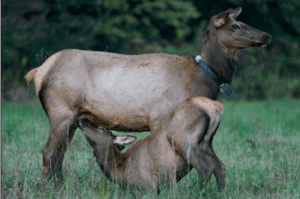 Elk, pollinators, and the Cherokee community all saw positive impacts thanks to a generous grant from the Glass Foundation. In partnership with the Eastern Band of Cherokee Indians Office of Fisheries and Wildlife Management (EBCI) and the NC Wildlife Resources Commission (NCWRC), this project made significant strides in protecting elk, reducing human-wildlife conflict, and expanding pollinator habitat.
Elk, pollinators, and the Cherokee community all saw positive impacts thanks to a generous grant from the Glass Foundation. In partnership with the Eastern Band of Cherokee Indians Office of Fisheries and Wildlife Management (EBCI) and the NC Wildlife Resources Commission (NCWRC), this project made significant strides in protecting elk, reducing human-wildlife conflict, and expanding pollinator habitat.
Five elk were successfully captured and collared in Maggie Valley, Ela, and Harmon Den, with plans to collar five more in December. Radio collars now allow monitoring of elk movements and improvement of management practices to minimize conflicts with people. In addition, six new fences were built and more than ten existing enclosures were maintained across the Qualla boundary, with more fencing planned for the year ahead to protect gardens and crops from elk browsing.
Pollinator habitat also saw a boost: a 5-acre plot at Kituwah Mound was planted with native wildflowers and grasses, and subsequent surveys documented at least 15 plant species along with the threatened American bumblebee. Additional seeding on six Mt. Noble plots, supported by tribal construction crews, was expected to further strengthen habitat in the spring.
Chimney Swift Conservation
 Once nesting in hollow trees and open chimneys, chimney swifts have lost much of their habitat to urbanization, deforestation, and modern construction practices. To help restore what has been lost, NCWF, Cape Fear Audubon, and community site partners across Wilmington built three custom chimney swift towers this year. Funded by the Women’s Impact Network of New Hanover County and Duke Energy, each tower provides essential roosting and nesting space for this Species of Greatest Conservation Need (SGCN), while also celebrating the local landscape.
Once nesting in hollow trees and open chimneys, chimney swifts have lost much of their habitat to urbanization, deforestation, and modern construction practices. To help restore what has been lost, NCWF, Cape Fear Audubon, and community site partners across Wilmington built three custom chimney swift towers this year. Funded by the Women’s Impact Network of New Hanover County and Duke Energy, each tower provides essential roosting and nesting space for this Species of Greatest Conservation Need (SGCN), while also celebrating the local landscape.
At the Longleaf Environmental Learning Center, a 14-foot tower was built among wildflowers as a teaching tool and sanctuary; at Willowdale Urban Farm, a mural-adorned tower will support wildlife and local growers; and at Maides Park, a tower now stands in a restored pollinator meadow that helps protect the Burnt Mill Creek watershed. Together, these towers provide new habitat for chimney swifts while supporting pollinators and engaging the community in conserving North Carolina’s natural heritage.
Wildlife Surveys in the Craggy Mountains
North Carolina’s mountain forests are home to some of the state’s most at-risk wildlife. Many bat species face steep 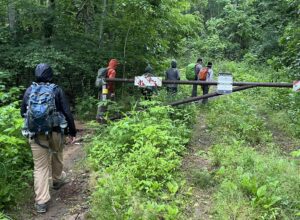 population declines from habitat loss, disease, and other pressures, while migratory songbirds like the cerulean warbler have suffered dramatic population drops due to the loss of mature deciduous forests. The Pisgah and Nantahala National Forests, including the 16,000-acre Craggy Mountains area, provide some of the best remaining habitat for these species, making conservation and monitoring efforts critical.
population declines from habitat loss, disease, and other pressures, while migratory songbirds like the cerulean warbler have suffered dramatic population drops due to the loss of mature deciduous forests. The Pisgah and Nantahala National Forests, including the 16,000-acre Craggy Mountains area, provide some of the best remaining habitat for these species, making conservation and monitoring efforts critical.
To inform science-based management, NCWF partnered with the National Parks Conservation Association, North Carolina Wildlife Resource Commission (NCWRC), and other conservation organizations to conduct coordinated surveys of bats and cerulean warblers. Acoustic recording units and SonoBat software captured bat activity in old-growth and maturing second-growth forests, while bioacoustic recorders and LiDAR technology documented avian diversity. These surveys help fill critical knowledge gaps about population health, habitat use, and long-term recovery trends, particularly following recent storm impacts.
Findings from these efforts will guide future forest management, habitat protection, and restoration strategies. By advancing understanding of the Craggy Mountains’ bats, birds, and broader wildlife communities, NCWF and partners aim to ensure these species – and the rich biodiversity they represent – have a chance to recover and thrive, while promoting lasting protections for these mountain forests.
Support for Hellbender Endangered Species Listing
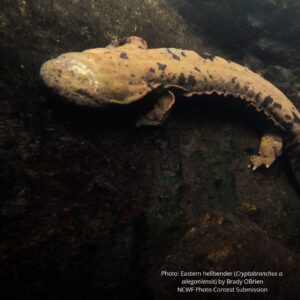 This year, NCWF joined the Southern Environmental Law Center (SELC) and other conservation partners to support the listing of the eastern hellbender as an endangered species under the Endangered Species Act. Once found throughout Appalachian and Mid-Atlantic rivers, the hellbender had disappeared from more than 40 percent of its historical range, and only a handful of remaining populations were stable. Recent damage from Hurricane Helene to some of the species’ last strongholds showed just how vulnerable it had become.
This year, NCWF joined the Southern Environmental Law Center (SELC) and other conservation partners to support the listing of the eastern hellbender as an endangered species under the Endangered Species Act. Once found throughout Appalachian and Mid-Atlantic rivers, the hellbender had disappeared from more than 40 percent of its historical range, and only a handful of remaining populations were stable. Recent damage from Hurricane Helene to some of the species’ last strongholds showed just how vulnerable it had become.
Across its range, hellbenders continue to decline due to sedimentation, polluted runoff, degraded water quality, and the loss and fragmentation of clean, cold stream habitat. Sedimentation – from development, agriculture, roadbuilding, and logging – fills in the rocky streambeds where hellbenders shelter, reproduce, and breathe. Additional stressors such as wastewater discharges, mining impacts, and altered river flows further isolate populations and diminish their resilience as storms intensify with climate change.
Given these persistent and compounding threats, the eastern hellbender clearly meets the criteria for endangered status. Listing would provide essential protections, improve coordination among agencies, and help secure the clean, connected streams the species need to survive.
Protecting Horseshoe Crabs
NCWF joined the Horseshoe Crab Recovery Coalition to urge continued protection of female horseshoe crabs. Despite decades of monitoring, horseshoe crab and red knot populations remain well below recovery targets, and recent spawning and migration seasons highlight the fragility of the species’ status on the landscape.
Horseshoe crab egg densities remain near some of the lowest levels recorded since the early 1990s. Red knots, which rely on these eggs during migration, continue to struggle, with only about 40 percent of birds leaving the bay in sufficient condition to complete migration and breed. Erratic spring weather, including cold winds and persistent rain, has further disrupted spawning in recent years.
NCWF and the Horseshoe Crab Recovery Coalition supported maintaining the moratorium on female harvest and reinstating seasonal restrictions that protect spawning activity. Safeguards preventing male harvest when sex ratios drop too low are also essential.
Pollinator Protection and Conservation: Frosted Elfing and Monarch Butterfly
Pollinator species across North Carolina and the broader Southeast continue to face mounting pressures from habitat loss,
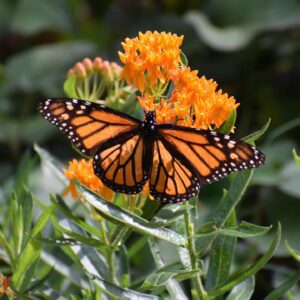
Monarch butterfly (Danaus plexippus) by Annemarie Chaussard, NCWF Photo Contest Submission
fragmented landscapes, and changing environmental conditions. Two species of particular concern – the frosted elfin and the monarch butterfly – highlight the urgency of coordinated conservation efforts grounded in science and long-term planning.
The frosted elfin, once distributed widely across the eastern United States, has experienced steep population declines, leaving significant gaps in knowledge about its current status and habitat requirements. NCWF supported the NCWRC, NC State University, and partners across multiple southeastern states in a regional initiative to survey remaining habitat, assess known populations, and evaluate genetic diversity. These efforts would inform management strategies such as prescribed fire, habitat restoration, and, where necessary, future captive breeding and reintroduction programs.
The monarch butterfly faces similar challenges on an even larger scale. Monarch populations have declined sharply across both eastern and western migratory routes due to habitat loss, climate-driven disruptions, and widespread pesticide use. NCWF and other affiliates of the National Wildlife Federation supported the proposal to list the monarch as a threatened species under the Endangered Species Act, recognizing that recovery required broad, coordinated action. Conservation priorities include protecting roadside habitats critical to migration, restoring milkweed and nectar-rich plant communities, and collaborating with federal agencies to mitigate pesticide impacts. Safeguarding key overwintering sites and expanding habitat in vulnerable regions are also essential steps toward stabilizing the species.
Clarifying Definitions for Wildlife Captivity Licenses
This year, NCWF submitted recommendations, which were accepted, regarding definitions for wildlife captivity licenses. Current common definitions of “native” and “non-native” were based on historical occurrences in North Carolina. NCWF believes these definitions were unclear and might misclassify species, particularly those expanding naturally into the state due to climate change or other environmental factors.
A facet of NCWF’s recommendations included updating the definitions as follows: a “native” species should include any wild animal or bird that occurs, reproduces, or maintains populations naturally in North Carolina without human introduction, including species historically present. A “non-native” species should include any species introduced by humans that has not historically occurred naturally in the state.
Updating these definitions improves consistency across NCWRC rules and supports accurate wildlife management in reducing any potential ambiguity, shifting ranges, and ensuring that North Carolina’s wildlife policies are scientifically accurate and enforceable.
Safeguarding Wildlife from New World Screwworm
NCWF joined livestock producers, wildlife managers, animal health experts, and landowners across the country in raising urgent concerns about the growing threat of New World screwworm, a parasite whose larvae infest the living tissue of warm-blooded animals, including livestock, pets, wildlife, and occasionally people.
While NCWF and partners commended the USDA’s recent Domestic Readiness and Response Initiative and its partnership to establish a sterile fly dispersal facility, the absence of a domestic facility remains a critical gap. Because the sterile insect technique is the most effective tool for preventing and controlling outbreaks, securing full federal funding and beginning construction of a U.S.-based facility are essential.
A major outbreak could carry severe economic and ecological consequences, with potential livestock losses in the billions and significant impacts on wildlife and rural communities. To reduce these risks, the coalition urged USDA to move quickly to establish the needed production capacity and fully utilize existing authority under the Animal Health Protection Act.
Habitat
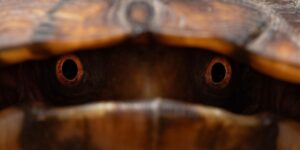
Photo: Eastern box turtle (Terrapene carolina carolina) by Shreyes Chalasani, 2025 NCWF Photo Contest Youth Winner
“The planned and orderly development and conservation of our natural resources is the first duty of the United States. It is the only form of insurance that will certainly protect us against the disasters that lack of foresight has in the past repeatedly brought down on nations since passed away.” – Gifford Pinchot, First Director of the US Forest Service
Effective wildlife conservation requires a thoughtful, proactive, and nuanced approach to habitat management and restoration. No part of North Carolina’s landscape has remained entirely untouched by human activity, though the extent of that impact varies. Some habitats may appear much as they did centuries ago, before colonization, while others have been significantly altered by rapid urbanization, suburban expansion, and other forms of development. These changes bring challenges such as pollution, habitat degradation, invasive species, and more – all contributing to the decline of native ecological communities. Despite these challenges, some wildlife continues to thrive in these altered environments, but protecting, conserving, and restoring them demands intentional management and active engagement.
Restoring and nurturing habitats to support wildlife requires both private and public land management strategies that prioritize ecological health. NCWF leads these efforts in North Carolina through policy advocacy and a robust network of Community Wildlife Chapter volunteers. This work has become especially crucial in the aftermath of Hurricane Helene and the destruction it caused, particularly in the western part of the state.
Charlotte’s Policy Reform Addresses Gardening for Wildlife
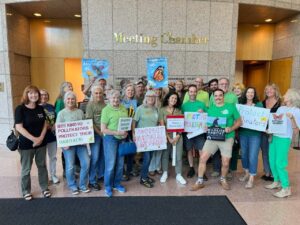 This fall, NCWF Charlotte Wildlife Stewards Chapter led a coalition aimed at adding a height exemption for plant growth by those gardening for wildlife.
This fall, NCWF Charlotte Wildlife Stewards Chapter led a coalition aimed at adding a height exemption for plant growth by those gardening for wildlife.
Currently, a landowner can receive a code violation for plants that exceed 12 inches in height, which is contrary to the positive benefits native plants have for local wildlife, such as birds and pollinators. After months of speaking at public forums, sending hundreds of emails, and making countless phone calls, Charlotte’s mayor announced her commitment to do the work needed to change the ordinance.
This is a major win for wildlife conservation in Charlotte. By codifying the exemption, the city turns its values into policy, sending a clear message that the city is committed to its principles.
Wetlands Protections
NCWF joined formal comments urging the U.S. Environmental Protection Agency (EPA) and the Army Corps of Engineers (ACE) to protect the nation’s remaining wetlands and streams under the Clean Water Act. This work followed ongoing legal efforts in North Carolina, where NWF and NCWF – represented by the SELC – continue to oppose attempts to further weaken federal wetlands protections in the wake of the Supreme Court’s 2023 Sackett v. EPA decision.
NWF’s new comments emphasized that federal Clean Water Act safeguards are essential to public health, wildlife habitat, flood mitigation, and the integrity of aquatic ecosystems. The definition of “Waters of the United States” (WOTUS) determined which waters receive these protections, and years of rollbacks have already left wetlands and intermittent streams increasingly vulnerable.
NCWF urged the EPA and ACE to retain the 2023 conforming WOTUS rule, which aligns with Sackett while still protecting critical wetlands and small streams. The comments called for any future revisions to follow a transparent, science-based process and for key terms to be clarified in ways that uphold the Clean Water Act’s mandate to maintain the chemical, physical, and biological integrity of the nation’s waters.
Wildlife Crossings – Infrastructure Policy and Wildlife Conservation
As national transportation planning entered a new phase, the U.S. Department of Transportation’s (NCDOT) request for public comment offered a key opportunity to reinforce how infrastructure policy could better serve both communities and wildlife. The most recent federal transportation bill – the bipartisan Infrastructure Investment and Jobs Act – marked historic progress by integrating transportation development with natural resource conservation. Through initiatives like the Wildlife Crossings Pilot Program, investments in resilient infrastructure, and expanded support for habitat connectivity, Congress set a new standard for designing transportation systems that were safer, smarter, and more sustainable.
Building on this foundation, NCWF joined in submitting recommendations urging Congress to strengthen these gains in the next transportation bill. These comments highlighted the ongoing need for robust federal support for wildlife crossings and the importance of broadening eligibility for habitat-focused projects across major transportation programs. Additional recommendations focused on investing in workforce development, research, and data systems that would allow agencies to better plan for wildlife movement and habitat needs.
Community Wildlife Chapter Habitat Restoration Impacts
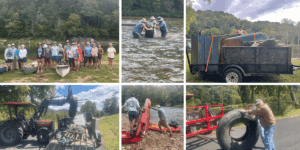
September 6, Mountain Island Cleanup. NCWF’s High Country Wild and partners joined forces for an unforgettable experience on the New River in Alleghany County. The crew removed 3200 lbs of trash and debris in an effort to keep our waterways clean and maintain suitable habitat for the abundance of both terrestrial and aquatic wildlife that rely on the New River.
NCWF’s volunteer programs continued to make a substantial impact this year, with 12,537 people actively engaged in conservation efforts across the state.
- Removing litter from wildlife habitats helps protect animals from potential harm, such as ingestion or entanglement in plastic and other debris. Clean environments support the health of ecosystems by maintaining the balance of plant and animal life. It also prevents pollution from contaminating water sources and soil, which can poison species or disrupt food chains. By reducing litter, we ensure that habitats remain suitable for wildlife to thrive, promoting biodiversity and ecological stability.
NCWF volunteers safeguarded aquatic and terrestrial habitats by removing 71,819 pounds of litter and debris. This number represents a 37.9% decrease from last year, but is largely due to the unusually high post-Hurricane Helene cleanup total in 2024.

November 8, Habitat Workday: NCWF Union County Wildlife Chapter partnered with Union County Parks and Recreation and Catawba Lands Conservancy to remove invasive species and improve habitat for the endangered Schweinitz’s sunflower in the prairie at Cane Creek Park.
- Planting native plants enhances wildlife habitats by providing food, shelter, and nesting sites tailored to the needs of local species. Native plants support biodiversity by attracting and sustaining pollinators, birds, and other wildlife that rely on them for survival. They help maintain ecological balance by stabilizing soil, conserving water, and reducing the spread of invasive species that can threaten local ecosystems. Overall, native plants promote a healthier, more resilient environment that supports the long-term well-being of wildlife.
This year, NCWF restored wildlife habitat by planting 69,351 native plants, including 31,780 trees, 2,532 shrubs, and 3,336 pollinator plants, compared to last year’s total of 23,220, a 199% increase.
- Removing invasive plant species restores the health of wildlife habitats by preventing these non-native plants from outcompeting native vegetation. Invasive species can disrupt food sources and disrupt the natural balance, harming the animals that depend on native plants for shelter, food, and breeding. By removing invasive plants, we allow native plants to thrive, which in turn supports local wildlife, enhances biodiversity, and helps maintain ecosystem stability. This process improves soil health, water quality, and overall habitat resilience.
NCWF and its volunteers removed invasive vegetation from 18 acres of habitat this year, maintaining the level of impact achieved last year.
The significant increase in native plantings can again be attributed in part to two large-scale restoration projects, including the Atlantic white cedar initiative at Millennium Forest in Pocosin Lakes National Wildlife Refuge and the longleaf pine restoration on the Upper Chowan West Tract:
- Longleaf Pine Restoration Project
NCWF’s longleaf pine restoration project on the Upper Chowan West Tract represented a significant investment in improving habitat quality within Chowan Swamp Game Land. The 70-acre site, situated within an N.C. Heritage Program buffer, provides an opportunity to replace a former loblolly pine plantation with longleaf pine, a species better suited to the area’s sandy soils and ecological history. This conversion supports a wider range of wildlife, including game species, pollinators, and early-successional specialists, while enhancing conditions for prescribed burning and long-term habitat maintenance.
While many habitat improvement efforts occur in more fragmented landscapes where development pressures limit restoration potential, projects like this one in protected game lands contribute to the recovery of fire-dependent native species in more resilient environments. The loblolly pine harvest completed in 2025 and subsequent site preparation laid the groundwork for planting longleaf pine seedlings in December, establishing a foundation for future monitoring and adaptive management.
- Atlantic White Cedar Project
Atlantic white cedar (Chamaecyparis thyoides) is a conifer native to the coastal plain from Maine to Florida and west to Mississippi, thriving in freshwater swamps such as pocosins, bogs, and stream margins. Extensive logging in the 1800s and 1900s, coupled with wetland drainage and reduced fire, has prevented these forests from recovering in North Carolina. Their decline threatens wildlife uniquely dependent on them, including the Hessel’s hairstreak butterfly and yellow-throated warbler, while also diminishing important ecosystem services like water filtration and carbon sequestration.To restore this globally threatened habitat, NCWF has partnered with Pocosin Lakes National Wildlife Refuge to plant tens of thousands of Atlantic white cedar seedlings. In 2024, funding supported the planting of more than 14,000 seedlings across the Millennium Forest and Pungo Unit, followed by an additional 30,600 planted later that year with support from Apex Clean Energy. On November 22, volunteers – including former refuge managers—hand-planted 350 seedlings grown by Mellow Marsh Farm, celebrating a shared commitment to long-term conservation.Looking forward, restoration efforts face challenges from heavy deer browsing, which threatens young cedar survival. To address this, seedlings grown by the NC Forest Service were treated with the deer repellent Trico Pro, and NCWF and USFWS will monitor treated and untreated seedlings to evaluate effectiveness. The results will help guide future large-scale tree-planting projects across eastern North Carolina.
Additionally, this year community members across the state have registered 4,597 Pollinator Pitstops on NCWF’s Butterfly Highway to date, with 809 just this year, compared to 420 registered in 2024. This represents a 92.7% increase and is largely the result of expanded digital advertising and heightened promotional efforts that raised awareness of the Butterfly Highway and encouraged wider public participation in creating pollinator-friendly spaces.
Alongside the 17,198 Certified Wildlife Habitats registered in North Carolina to date, these efforts reflect the ongoing dedication of volunteers and community partners who continue to take meaningful steps to restore habitat and strengthen wildlife conservation across North Carolina.
Butterfly Highway Seed Study Begins at Daniel Stowe Conservancy
This year, NCWF’s Butterfly Highway program launched a new efficacy study to better understand how its native seed mixes perform under different conditions. In partnership with Belmont’s Daniel Stowe Conservancy, the project will ultimately establish 18 seed plots along the sidewalks leading to the garden entrance.
The first step took place this fall. On November 14, 2025, staff and volunteers installed six test plots, removing sod by hand and loosening the soil before sowing seed. Three plots were placed in full sun and three in part shade, each bordered with a clean hard edge to prevent lawn encroachment and minimize mowing impacts.
These installations marked the beginning of a two-season study that will continue into winter 2026, comparing seed performance by season and by site-preparation method.
People
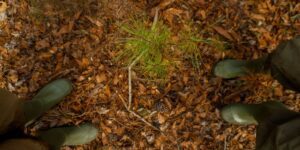
Photo by Haley Nelms, NCWF 2025 Photo Contest Winner
“There’s a long-standing maxim in conservation circles: people support what they love, and they love what they know.” Greg Peters, Our National Forests
NCWF is a dedicated wildlife organization, and our core mission revolves entirely around the protection, conservation, and restoration of wildlife. However, our work cannot be achieved in isolation – it relies on the commitment, energy, and passion of people. People are the driving force behind everything we do. As highlighted in our habitat efforts, our network of volunteer conservationists within our Community Wildlife Chapters plays a crucial role in hands-on habitat restoration. Yet, this impact extends far beyond this through our collaborative efforts with the broader conservation community, particularly through our education and wildlife training programs.
These programs are central to empowering individuals with the knowledge and skills needed to contribute effectively to wildlife conservation in their own yards and communities. By educating and training the next generation of conservation leaders, we foster a network of informed, engaged citizens who are better equipped to advocate for and protect wildlife.
In 2025, these programs had a profound influence on the conservation community throughout North Carolina. From training volunteers in effective habitat management to providing resources for local landowners and communities, educational initiatives are creating tangible, lasting change.
Addressing the Impact of Federal Budget Cuts on Wildlife Conservation
Across the country, wildlife and communities rely on the steady work of federal agencies that safeguard clean water, restore habitat, guide disaster response, and support the science that shapes sound public policy. Yet, this year, proposed budget and staffing cuts threatened this essential work, putting ecosystems, local economies, and public safety at risk.
NCWF joined in urging Congress to consider the true costs of reducing agency capacity. Comments highlighted the integral roles played by agencies such as the U.S. Fish and Wildlife Service, National Park Service, Environmental Protection Agency, and the U.S. Department of Agriculture. These institutions provide the scientific expertise, technical assistance, and on-the-ground support that communities across the nation depend on every day.
NCWF joined its national partners in underscoring a simple message: cuts might have appeared fiscally prudent on paper, but the losses to wildlife, public health, and community well-being are far greater. Preserving these agencies’ capacity is essential to maintaining the services that millions of Americans and countless species rely on every day.
New NCWF Community Wildlife Chapters
NCWF’s Community Wildlife Chapter network is ever-expanding, and the newest additions arrived this year through four new chapters!
Swannanoa Valley WILD!
Serving the communities of Swannanoa, Black Mountain, and Montreat, Swannanoa Valley WILD! brings people together through habitat restoration, nature connection, and environmental education. One of the chapter’s main projects has been restoring Fox Creek Park, a beloved green space left damaged by Hurricane Helene and overrun with invasive species like kudzu and multiflora rose.
From tree planting and streambank restoration to nature journaling and guided walks, Swannanoa Valley WILD! is creating ongoing opportunities for residents to engage in meaningful conservation.
High Country Wild
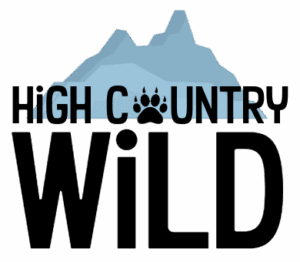
Covering Ashe and Watauga counties, with plans to expand into Alleghany, High Country Wild is rooted in one of the state’s richest ecological regions. Home to rare and vital habitats – spruce-fir forests, mountain bogs, and high-elevation rock outcrops—the High Country supports species like the hellbender, bog turtle, northern flying squirrel, and spruce-fir moss spider.
High Country Wild focuses on restoration and education, especially for Species of Greatest Conservation Need. Looking ahead, the chapter plans to lead habitat restoration efforts – such as revitalizing spruce-fir forests and restoring bogs – and host educational programs to inspire a new generation of conservationists.
Fall Line Outdoors Chapter
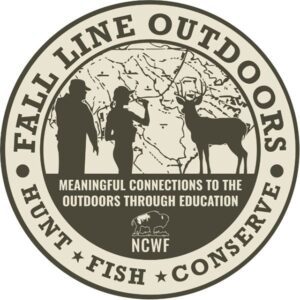 Serving Cumberland, Lee, and Harnett Counties Fall Line Outdoors (FLOC) Chapter is dedicated to helping people safely and responsibly experience North Carolina’s outdoors. Grounded in respect for the state’s wildlife and habitats, Fall Line Outdoors brings together hunters, anglers, and conservation-minded residents who recognize that time spent afield fosters both skill and stewardship.
Serving Cumberland, Lee, and Harnett Counties Fall Line Outdoors (FLOC) Chapter is dedicated to helping people safely and responsibly experience North Carolina’s outdoors. Grounded in respect for the state’s wildlife and habitats, Fall Line Outdoors brings together hunters, anglers, and conservation-minded residents who recognize that time spent afield fosters both skill and stewardship.
The chapter’s mission is to introduce newcomers to ethical hunting and fishing traditions through hands-on education, safety instruction, and conservation engagement. With support from certified instructors and experienced volunteers, participants learn practical skills – from firearm and boating safety to fish ecology and wildlife identification – while gaining an understanding of the responsibilities that come with outdoor recreation.
ReWild AVL Chapter
An upcoming Community Wildlife Chapter in Asheville, ReWild AVL will focus on three key priorities: restoring and promoting wildlife habitat in Asheville, serving as a voice for wildlife as the city rebuilds, and connecting local residents with the outdoors to foster community engagement.
ReWIld AVL aims to advance habitat restoration projects, advocate for wildlife-friendly development, and provide opportunities for residents to participate directly in conservation work. Through these efforts, the chapter will help ensure Asheville’s wildlife and natural spaces thrive for generations to come.
Community Wildlife Chapter Nature Outings and Educational Opportunities
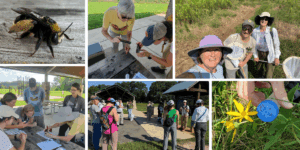
August 17, Bumble Bee Atlas Survey: NCWF Charlotte Wildlife Stewards chapter partnered with the Central Carolinas Master Naturalist Program to participate in the Southeast Bumble Bee Atlas, a community science project led by the Xerces Society to track bumble bee populations across the Southeast. Volunteers collected and captured bumble bees for documentation and data collection. Data collected from the Bumble Bee Atlas helps advance conservation efforts for bumble bees in NC and across the country.
Engaging people with nature and providing science-based conservation education ensures that interest does not become stagnant, but grows into action.
NCWF Wildlife Chapters continued offering wildlife and nature outings that immerse participants in the outdoors and highlight the importance of protecting natural habitats. In 2025, NCWF Community Wildlife Chapters hosted 419 activities including 217 educational wildlife programs and 20 wildlife webinars.
Many of these virtual webinar presentations remain available for ongoing learning on our YouTube channel, ensuring the information continues to inspire long after each one concludes. These resources empower individuals to become active participants in conservation and strengthen their connection to the natural world.
Youth and Family Engagement
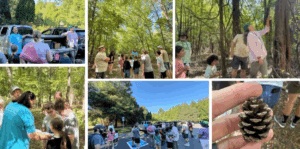
September 13, Terrific Tree Adventure: NCWF Habitat Builders of West Union chapter engaged youth and families in a terrific tree adventure at Marvin Efird Park. Participants discovered seeds, leaves, and bark during hands-on activities. The group took a walk through the park to find some special native trees.
One of NCWF’s most important roles is preparing the next generation of conservation leaders. Through youth programs and educational opportunities, NCWF introduced young people to the wonders of wildlife and the outdoors. In 2025, NCWF engaged 3,302 youth with wildlife and the outdoors. Youth participation included Kids in Nature Days, ecoEXPLORE activities with community libraries, day trips, nature walks, scavenger hunts, and programs highlighting wildlife’s role in healthy ecosystems.
NCWF’s Great Outdoors University also provided meaningful opportunities for outdoor learning. Last year, the program hosted 75 day trips serving 2,294 participants, including 1,972 youth and 322 adults.
These experiences foster curiosity, build ecological knowledge, and inspire young people to become lifelong stewards of the environment – ensuring the future of wildlife conservation remains strong.
Wildlife Habitat Stewards Training
NCWF worked to build community conservation leadership through its new Wildlife Habitat Stewards Training program. This year, 126 people participated in five Wildlife Habitat Stewards Trainings. Stewards learned how to expand community capacity to support habitat restoration, wildlife-friendly land management, and local conservation initiatives. These individuals were trained to guide community action and strengthen on-the-ground conservation efforts across the state.
Hunting Education
NCWF recognizes hunting as an essential tool for recruiting new participants, supporting wildlife management, and promoting conservation. Hunting encourages public involvement in habitat stewardship and wildlife population management while simultaneously providing funding for conservation.
In 2025, NCWF Community Wildlife Chapters continued providing hands-on learning opportunities for beginners. NCWF Gaston PAWS Chapter partnered with the NCWRC’s Learn to Hunt program to offer experiential education in turkey, squirrel, and deer hunting. On March 29, the Learn to Hunt Turkey Program introduced 32 participants to ethical, conservation-minded hunting practices through a combination of seminars and skill-based stations covering wildlife biology, hunter safety, scouting, calling, shooting, and game processing.
In addition, NCWF’s new Fall Line Outdoors Chapter (FLOC) led four hunting education events, covering deer hunting, deer processing, and outdoor skills. The chapter also participated in National Hunting and Fishing Day and attended the Golden Goose Waterfowl Tournament to table and kick off the event, providing hundreds of participants with hands-on education and strengthening community engagement in hunting and conservation.
This year’s program emphasized the connection between hunting and conservation, teaching participants how hunting supports wildlife management and sustainable practices. The events were inclusive, attracting participants of all ages, genders, and backgrounds, many of whom were invited to return for mentored hunts to reinforce ethical hunting skills.
Red Wolf Center and Live Cams
A key focus of NCWF’s conservation efforts is the Red Wolf, the world’s most endangered canid, which now exists solely in North Carolina. One of the ways NCWF supports the recovery of this species is by operating the Red Wolf Center. In 2025, the Red Wolf Center welcomed 590 visitors and offered 241 programs. These programs continue to play a vital role in educating the public about the Red Wolf’s plight and the ongoing efforts to restore this species to the wild, making the center an essential resource for raising awareness and fostering support for Red Wolf conservation. The Red Wolf Center was on track to set a new visitation record, but the government shutdown forced its closure, preventing it from reaching that milestone.
The Red Wolf Live Cams once again drew significant attention, collectively receiving 517,296 views. Much of this traffic was due to the publicity of the two resident Red Wolves at the center.
Additionally, the Heron Live Cam and the Osprey Live Cam on Lake Norman received 1,211 views and 260,329 views, respectively. While Heron Cam viewership was lower this year, the Osprey Cam experienced a notable increase in engagement.
Scholarships

Mason Ibrahim of Duke University received the $2,500 Alamance Wildlife Club sponsored scholarship for her work in large-scale coastal restoration and habitat revitalization.
For more than 50 years, NCWF has provided scholarship funds to support students pursuing research and careers in wildlife conservation and related fields.
By investing in the education and research of these emerging conservationists, students are encouraged and empowered to pursue a future where wildlife and natural habitats continue to be protected and restored. Each of these students brings a unique focus – ranging from molecular genetics and aquatic ecology to environmental restoration and education – that contributes to the broader mission of sustaining North Carolina’s natural resources.
In 2025, NCWF awarded more than $14,000 in scholarships to seven undergraduate, graduate, and Ph.D. students from NC State University and Duke University. Scholarship amounts ranged from $1,500 to $2,500, helping recipients advance their studies in wildlife biology, genetics, environmental management, and community-based conservation.
Mason Ibrahim of Duke University received the $2,500 Alamance Wildlife Club sponsored scholarship for her work in large-scale coastal restoration and habitat revitalization, and Sweta Dixit of NC State received the $2,500 Conservation Leadership Scholarship for her research on the human dimensions of wildlife conservation and coexistence. Additional $1,500 scholarships were awarded to Isabella Livingston, Alyssa Weeks, Devin Raburn, and Paige Meadows of NC State, and Annabelle Dyer of Duke University.
Photo Contest
In addition to our educational efforts and hands-on engagement, NCWF believes it is essential to continue celebrating the beauty of wildlife and the outdoors – and honoring those who help highlight it through their own work. This year, NCWF hosted the 7th Annual Wildlife Photo Contest, showcasing the diverse wildlife and habitats of North Carolina, from the coast to the mountains. The contest featured categories such as Critters, People in Nature, Scenes of North Carolina, and Pollinators. All entries were anonymously judged by a panel of 15 experts, who selected this year’s winners and honorable mentions, celebrating the talent and passion of those who capture the essence of our natural world.

